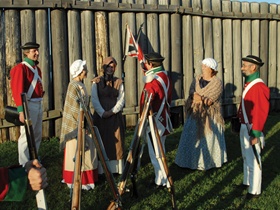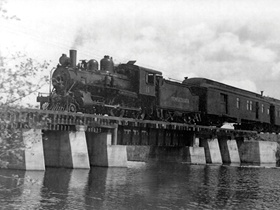
 More than 60 prehistoric archaeological sites bear witness to the presence in the area of Aboriginal People who came here to look for Chert, a flint like stone with exceptional properties. The oldest site at Saint-Michel-du-Squatec dates back more than 9,000 years.
More than 60 prehistoric archaeological sites bear witness to the presence in the area of Aboriginal People who came here to look for Chert, a flint like stone with exceptional properties. The oldest site at Saint-Michel-du-Squatec dates back more than 9,000 years.
The first seigneury, following the French model, was that of the Seigneury of Madawaska, established in 1683. It was granted to the merchant Charles-Aubert de la Chesnaye who was a fur trader in the region in the 17th century.
The fourth holder of the seigneury was James Murray, the Governor General of Canada, in 1763. He was succeeded in turn by Henry Caldwell, Alexander Fraser and Joseph Bouchette,Surveyor General of Canada.
The first permanent resident of Témiscouata was Philip Long in 1809. His farm was located in the vicinity of Fort Ingall.
The first Acadian to settle in Témiscouata was Israël Robichaud, a lumberjack who would have cut the wood to build Fort Ingall.
The Témiscouata Portage Route (60km) was the first inter-colonial road between settlements. It played primarily a military role, but was also important for mail and commerce.
The Aroostook War, a border conflict between the British North American colony and the United States, led to the construction of an outpost at Fort Ingall in 1839 and another at Dégelis.
There were 3 waves of colonization between 1850 and 1960: the area around the road 185, the Transcontinental sector and the area to the east of lake Témiscouata.
A new road, route 2, was built (1856 to 1862 )providing an axis of communication with New Brunswick. Highway 185 followed in 1970.
The Témiscouata Railway was built in 1885, connecting Edmundston and Rivière-du-Loup.
The arrival of the railway in the Transcontinental sector, commissioned in 1914 and connecting the cities of Québec and Moncton, led to a growth in population and the founding of several municipalities.
The naturalist Grey Owl arrived in the region in 1928 and wrote his first two books here.
Two important war heroes came from Témiscouata: Lieutenant-Colonel Dollard Ménard DSO GOQ CD, and Brigadier General Paul Triquet, VC CD.
At the end of the 19th century the forestry industry expanded with the arrival of the Fraser Company. Their mill was destroyed by fire in 1966, and this, together with the decline in the forestry industry, has led to the search for new avenues.
A popular uprising brought about the construction in 1974 of the Cascade Paper Mill, now Norampac.
In the 1970s the policy of the Eastern Québec Development Office of closing some of the villages led to Operation Dignity, an exemplary campaign in the region east of Lake Témiscouata.
Due to its proximity with the United States the Transcontinental region was infamous for smuggling alcohol, the most famous bootlegger in Témiscouata being Alfred Lévesque.
Témiscouata has been marked by several fires, including one in 1923 which stretched for more than 58 km between St-Honoré and St-Marc-du-Lac-Long. In 1950 half the town of Cabano was destroyed by fire.
The county of Témiscouata was created in 1853, and the Témiscouata Regional Municipality in 1972.
The town of Pohénégamook was formed in 1973 from the fusion of Saint-David-de-Sully and Saint-Pierre d'Estcourt with Saint-Éleuthère.
In 2010 the towns of Cabano and Notre-Dame-du-Lac joined together, creating the town of Témiscouata-sur-le-Lac.